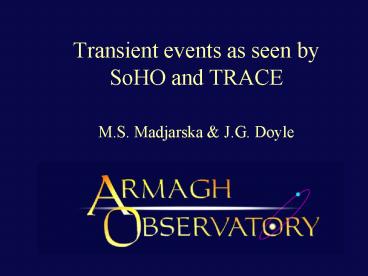Transient events as seen by SoHO and TRACE - PowerPoint PPT Presentation
1 / 16
Title:
Transient events as seen by SoHO and TRACE
Description:
S VI intensity images with overploted: Left panel: magnetogram contour map, ... et al. (1999) - enhancements in the intensity flux of transition region lines (O ... – PowerPoint PPT presentation
Number of Views:17
Avg rating:3.0/5.0
Title: Transient events as seen by SoHO and TRACE
1
Transient events as seen by SoHO and TRACE
- M.S. Madjarska J.G. Doyle
2
We will review the observational characteristics
of transient phenomena
- Spicules, EUV Bright Points, Explosive events,
Blinkers, Network and cell brightenings - Discuss their appearance in different
instrument observations - Discuss their similarities and/or differences.
3
Spicules
- Secchi (1877), Beckers (1972) ,Wilhelm (2000)
and Sterling (2000) - Chromospheric jet-like structures (H?)
- Te 1.3 104 K and Ne 1 1011 cm-3
- Lifetime - less than 15 mins, 14 arcsec long, 2
arcsec in diameter - Accelerated in 30 s over 1.5 arcsec to a const
speed of 25 km/s - Disappear or fall back, occasionally forming an
arch - Associated with the magnetic elements of the
chromospheric network - Tend to cluster in bushes (Pikelner 1969) or
rosettes (Uchida 1969) - Dark mottles were associated with spicules -
(Georgakilas et al. 2001, Zachariadis et al.
2001, Tziotziou et al. 2003) - H? spicules ? EUV spicules (from N II to O V)
- TR envelope of the spicules (Mariska et al. 1978,
Withbroe 1983)
4
- Budnik et al. (1998) - evaporation of spicular
material - Macro-spicules (1969) - cor. hole feature, length
- 5 to 60 arcsec, width - 5 to 30 arcsec (Bohlin
et al. 1975) - LOS velocities 200 km/s
- Parenti et al. (2002) - Te 2 105 K, Ne 2-3
1010 cm-3 - Macro-spicules ? Explosive events (Wilhelm 2000)
5
EUV Bright Points
- 1969 - Vaiana et al. (1970)
- Skylab mission - Golub 1980, Webb 1986, Habbal
1992 - Size - 30-40 arcsec
- Lifetime - EUV - 20 hrs (Zhang et al. 2001),
X-ray - 8 hrs (Golub et al. 1974) - Density - Ne (O IV) 1.9 1010, (Mg VII) 0.9 109 ,
(Si IX) 5 108 (Del Zanna et al. 2003) - quiet Sun and coronal holes, at the network
junctions - Associated with small bipolar magnetic features
(Webb et al. 1993, Brown et al. 2001, Madjarska
et al. 2003) - Sheely Golub (1979) - consist of 2-3 loops,
evolving 6 min - Habbal (1990) - complex of small-scale loops at
different temperatures
6
- Madjarska et al. (2003)
EIT observations in Fe X II 195 Å.
Magnetic field (MDI) temporal evolution.
7
S VI intensity images with overploted Left
panel magnetogram contour map, green - positive
polarity, blue - negative Right panel relative
Doppler shifts, green - 3 km/s, blue - -3 km/s,
red - 8 km/s.
Presence of small-scale ( 6 arcsec) transient
brightenings within the BP with a periodicity of
6 min. Doppler shift in the order from -10 to
10 km/s, predominantly red-shifted.
8
Explosive events
- Brueckner Bartoe (1983) - high velocity events,
from 2 104 K (C II) to 2 105 K (N V) , HRTS,
SUMER - Doppler shift up to 250 km s-1
- Spatial dimensions 3-4 arcsec, Lifetime 200
s - Network lanes Regions with weak and mixed
polarity fluxes or on the border of regions with
large concentration of magnetic flux - Chromospheric origin (Madjarska Doyle 2002) and
no evidence for presence at coronal temperatures
(Teriaca, Madjarska Doyle 2002) (SUMER) - Winebarger et al. (2002) - TRACE 171 Å response
of explosive events (SUMER)?!?!
9
- Increase with factor of 3 of the electron
density during explosive events. - Identified simultaneously in SUMER and CDS data
(Madjarska Doyle 2003)
10
Blinkers
- Harrison (1997), Harrison et al. (1999) -
enhancements in the intensity flux of transition
region lines (O III, O IV, O V) at the network
junctions - Modest appearance at coronal temperatures
- Lifetime 17 min, Area 8 ? 8 arcsec2
- Brkovic et al. (2001) - lifetime in the range
3-110 min - Average intensity increase of 1.5
- Occur above large or strong magnetic fragments
with 75 where one polarity dominates (Bewsher et
al. 2002) - Bewsher et al. (2002), Parnell et al. (2002)
- Identified in simultaneously obtained SUMER and
CDS data (Chae et al. 2000, Madjarska Doyle
2003)
11
- Within each blinkers, SUMER reveals the presence
of small-scale (3-5 arcsec), short-lived (2-3
min) bright features. - Small increase in the emission of the blue and
red wings - Doppler shifts in blinkers range from -5 to 25
km/s - predominantly red-shifted. - Magnetic flux increase during blinker phenomena
(BBSO).
12
Network and cell brightenings
- Harra et al. (2000) - CDS
- Network - larger, 150 s and 1026.9 ergs per
event - Cells - 96 s and 1025.8 per event
- 1-5 CDS pixels size
- Gallagher et al. (1999) - transient brightenings
(O V and He I/CDS) - Duration 80 - 200 s, Size 6 000 - 10 000 km,
LOS vel. 13 km/s - Berghmans et al. (1998) - EIT
13
Appearance in different instrument observations
- Explosive events - HRTS, SUMER, CDS, TRACE
- Blinkers - CDS, SUMER, EIT
- Bright Points - Skylab, HRTS, EIT, TRACE, Yohkoh,
SUMER, CDS - EUV Spicules - Skylab, EIT, TRACE, SUMER, CDS
- Network and Cell Brightenings - CDS, EIT
14
Are all these phenomena closely related or even
represent the same phenomenon but given different
names depending on their characteristics as
observed at particular wavelength or by a
particular instrument?
15
Similarities and Differences
- Blinkers ? Explosive events
- Blinkers ? Bright Points
- Blinkers ? Spicules and Macro-spicules
- Explosive events ? Spicules and Macrospicules
- Cell and network brightenings
16
- Better and more spatial, temporal and spectral
multi-instrument and multi-wavelength
observations are needed!!!!































